Sorcerer: The Flame Within
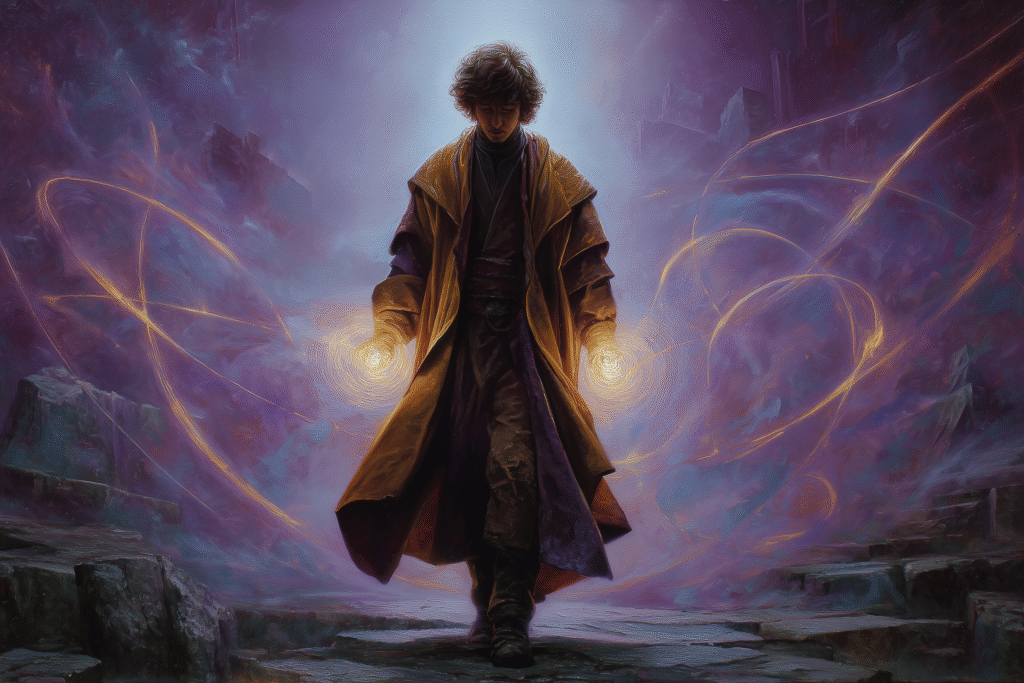
“Born not made. Called not taught. A whisper in the soul, a fire in the blood.”
Magic, for most, is learned—studied through dusty tomes, etched into symbols, bent to will through years of discipline. But not for you. The magic does not come from a teacher, a pact, or a god. It was always there. A flicker in the cradle. A spark in your scream. A wildfire waiting for wind.
You are a Sorcerer, a being whose essence is threaded with raw magic. While others search for the weave, you breathe it. Where wizards write incantations, you feel them. Where warlocks plead and bargain, you command. Your power is innate, an echo of something ancient in your blood or soul.
Each Sorcerer is unique, their magic shaped by its origin: the trace of dragonfire in your ancestry, the whispers of a broken star in your dreams, the cold gears of cosmic order ticking in your thoughts. No matter the source, the result is the same: you are a conduit of chaos and elegance—magic not as a craft, but as an instinct.
A Dangerous Gift
This power, though sublime, is unpredictable. A child who melts mirrors with a tantrum. A teenager whose dreams call shadows to dance. You may have been feared, worshipped, or shunned. Some Sorcerers embrace their legacy with pride. Others hide it, cursing every pulse of energy that surges through their veins.
Still, as you have grown, you have learned to shape this power. Sorcery Points and Metamagic are the tools with which you sculpt spells as a painter does color. You do not merely cast magic—you craft it in motion, bending the rules of the world to suit your will.
Yet deep down, the power is still wild. Still growing. And perhaps still dangerous.
Real-World Inspirations
Though Sorcerers are a unique creation of modern fantasy gaming, the idea of innate magic—of those born touched by power—has deep roots in myth, folklore, and occult traditions across cultures:
The Blood of Dragons
The idea of power passed through bloodlines echoes the legends of dragon-kin, fae-blooded lineages, or descendants of gods. In Chinese folklore, dragons were seen as symbols of divine right and magical potency—rulers were said to be born of dragon blood.
The Seers and Oracles
In Greek mythology, oracles like the Pythia at Delphi spoke with divine insight, not through study, but through ecstasy and trance—magic as possession rather than scholarship. Much like Sorcerers, their knowledge was not chosen, but received.
Psychic Mystics
The psychic movement of the 19th and 20th centuries, with figures like Helena Blavatsky and Edgar Cayce, claimed magic could awaken spontaneously within certain individuals—clairvoyants, mediums, and channelers who accessed powers without spells or rituals.
Occult and Genetic Magic
Modern fantasy and science fiction blur the lines between magic and mutation. In series like X-Men, powers manifest at birth, often tied to intense emotion or trauma—mirroring how Wild Magic Sorcerers erupt with uncontrollable energy.
The Sorcerer’s Journey
To walk the path of the Sorcerer is to walk a razor’s edge between mastery and mayhem. You are not a mage. You are magic made flesh.
Your power may inspire awe or dread, but it is yours, and yours alone.
Will you conquer it—or will it consume you?
Sorcerer Class (2024)
Sorcerer Class (Pathfinder)
Sorcerer Class (2024)
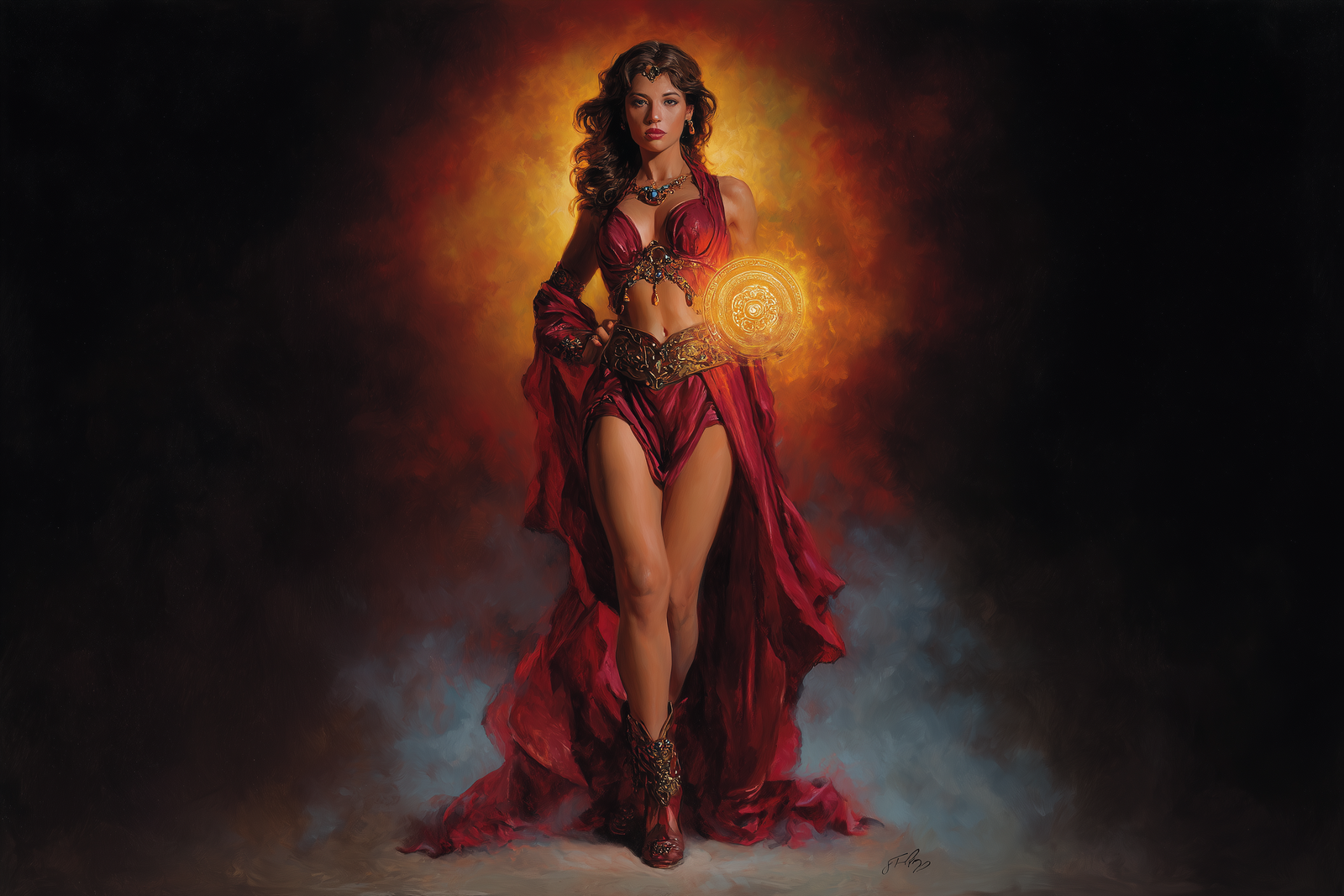
Class Features
As a Sorcerer, you gain the following class features.
Hit Points
- Hit Dice: 1d6 per Sorcerer level
- Hit Points at 1st Level: 6 + your Constitution modifier
- Hit Points at Higher Levels: 1d6 (or 4) + your Constitution modifier per Sorcerer level after 1st
Proficiencies
- Armor: None
- Weapons: Daggers, darts, slings, quarterstaffs, light crossbows
- Tools: None
- Saving Throws: Constitution, Charisma
- Skills: Choose two from Arcana, Deception, Insight, Intimidation, Persuasion, and Religion
Equipment
You start with the following equipment, in addition to the equipment granted by your background:
- (a) a light crossbow and 20 bolts or (b) any simple weapon
- (a) a component pouch or (b) an arcane focus
- (a) a dungeoneer’s pack or (b) an explorer’s pack
- Two daggers
Sorcerer Table
| Level | Proficiency Bonus | Features | Sorcery Points | Cantrips Known | Spells Prepared | 1st | 2nd | 3rd | 4th | 5th | 6th | 7th | 8th | 9th |
|---|---|---|---|---|---|---|---|---|---|---|---|---|---|---|
| 1 | +2 | Spellcasting, Innate Sorcery | — | 4 | 2 | 2 | — | — | — | — | — | — | — | — |
| 2 | +2 | Font of Magic, Metamagic | 2 | 4 | 4 | 3 | — | — | — | — | — | — | — | — |
| 3 | +2 | Sorcerer Subclass | 3 | 4 | 6 | 4 | 2 | — | — | — | — | — | — | — |
| 4 | +2 | Ability Score Improvement | 4 | 5 | 7 | 4 | 3 | — | — | — | — | — | — | — |
| 5 | +3 | Sorcerous Restoration | 5 | 5 | 9 | 4 | 3 | 2 | — | — | — | — | — | — |
| 6 | +3 | Subclass Feature | 6 | 5 | 10 | 4 | 3 | 3 | — | — | — | — | — | — |
| 7 | +3 | Sorcery Incarnate | 7 | 5 | 11 | 4 | 3 | 3 | 1 | — | — | — | — | — |
| 8 | +3 | Ability Score Improvement | 8 | 5 | 12 | 4 | 3 | 3 | 2 | — | — | — | — | — |
| 9 | +4 | — | 9 | 5 | 14 | 4 | 3 | 3 | 3 | 1 | — | — | — | — |
| 10 | +4 | Metamagic | 10 | 6 | 15 | 4 | 3 | 3 | 3 | 2 | — | — | — | — |
| 11 | +4 | — | 11 | 6 | 16 | 4 | 3 | 3 | 3 | 2 | 1 | — | — | — |
| 12 | +4 | Ability Score Improvement | 12 | 6 | 16 | 4 | 3 | 3 | 3 | 2 | 1 | — | — | — |
| 13 | +5 | — | 13 | 6 | 17 | 4 | 3 | 3 | 3 | 2 | 1 | 1 | — | — |
| 14 | +5 | Subclass Feature | 14 | 6 | 17 | 4 | 3 | 3 | 3 | 2 | 1 | 1 | — | — |
| 15 | +5 | — | 15 | 6 | 18 | 4 | 3 | 3 | 3 | 2 | 1 | 1 | 1 | — |
| 16 | +5 | Ability Score Improvement | 16 | 6 | 18 | 4 | 3 | 3 | 3 | 2 | 1 | 1 | 1 | — |
| 17 | +6 | Metamagic | 17 | 6 | 19 | 4 | 3 | 3 | 3 | 2 | 1 | 1 | 1 | 1 |
| 18 | +6 | Subclass Feature | 18 | 6 | 20 | 4 | 3 | 3 | 3 | 3 | 1 | 1 | 1 | 1 |
| 19 | +6 | Epic Boon | 19 | 6 | 21 | 4 | 3 | 3 | 3 | 3 | 2 | 1 | 1 | 1 |
| 20 | +6 | Arcane Apotheosis |
Class Features by Level
Level 1: Spellcasting
You have an innate ability to cast spells, drawing from the Arcane spell list. Your spellcasting ability is Charisma. You know a number of cantrips and spells as indicated in the Sorcerer table. You do not prepare spells daily; instead, you have a fixed list of known spells.
Level 1: Innate Sorcery
Your magic comes from an internal source, granting you unique abilities that set you apart from other spellcasters. This feature may include benefits such as resistance to certain damage types or enhancements to specific spells, depending on your Sorcerous Origin.
Level 2: Font of Magic
You gain access to Sorcery Points, a resource that allows you to manipulate your spells in various ways. You can use these points to create additional spell slots or fuel Metamagic options.
Level 2: Metamagic
You learn to twist your spells to suit your needs. At 2nd level, you gain access to Metamagic options, which let you modify your spells in specific ways, such as casting them silently or extending their range. You learn additional Metamagic options as you gain levels in this class.
Level 3: Sorcerous Origin
You choose a Sorcerous Origin, which grants you features at 3rd level and again at 6th, 14th, and 18th levels. Options include Draconic Bloodline, Wild Magic, Divine Soul, and others, each providing unique abilities and enhancements to your spellcasting.
Level 4: Ability Score Improvement
When you reach 4th level, and again at 8th, 12th, 16th, and 19th levels, you can increase one ability score of your choice by 2, or two ability scores by 1. Alternatively, you can choose a feat.
Level 5: Sorcerous Restoration
You regain a number of expended Sorcery Points equal to half your Sorcerer level (rounded up) when you finish a short rest.
Level 7: Sorcery Incarnate
Your mastery of sorcery allows you to enhance your spells further. This feature may grant benefits such as increased damage or additional effects when you use Metamagic.
Level 10: Metamagic Improvement
You gain an additional Metamagic option of your choice.
Level 17: Metamagic Mastery
You can use two Metamagic options on a single spell, provided you have enough Sorcery Points to do so.
Level 20: Arcane Apotheosis
You achieve the pinnacle of sorcerous power, gaining an epic boon that reflects your mastery over magic. This could include benefits like casting certain spells without expending a spell slot or immunity to specific conditions.
Sorcerous Origins
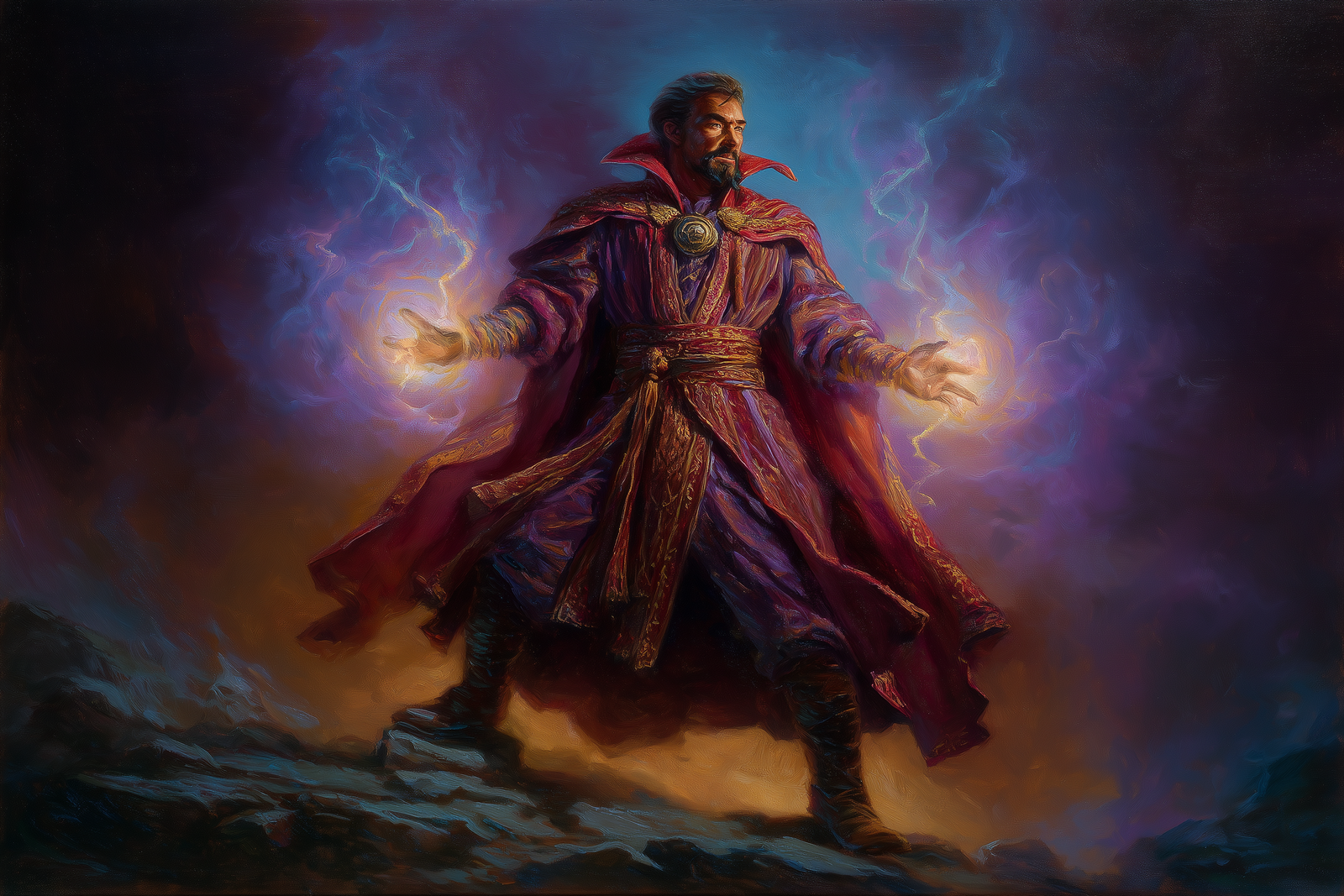
Draconic Bloodline
Your innate magic comes from the blood of dragons, granting you abilities tied to a specific dragon ancestry.
Level 3: Dragon Ancestor
Choose a dragon type (e.g., red, blue, gold) as your ancestor. This choice determines the damage type of your spells and grants you proficiency in the Draconic language.
Level 3: Draconic Resilience
Your hit point maximum increases by 1, and it increases by 1 again whenever you gain a level in this class. Additionally, parts of your skin are covered by a thin sheen of dragon-like scales, granting you an AC of 13 + your Dexterity modifier when not wearing armor.
Level 6: Elemental Affinity
When you cast a spell that deals damage of the type associated with your draconic ancestry, you can add your Charisma modifier to one damage roll of that spell. At the same time, you can spend 1 sorcery point to gain resistance to that damage type for 1 hour.
Level 14: Dragon Wings
You can sprout a pair of dragon wings from your back, gaining a flying speed equal to your current speed. You can create these wings as a bonus action on your turn. They last until you dismiss them as a bonus action. You can’t manifest your wings while wearing armor unless the armor is made to accommodate them, and clothing not made to accommodate your wings might be destroyed when you manifest them.
Level 18: Draconic Presence
You can channel the dread presence of your dragon ancestor, causing those around you to become awestruck or frightened. As an action, you can spend 5 sorcery points to exude an aura of awe or fear (your choice) to a distance of 60 feet. For 1 minute or until you lose your concentration (as if you were concentrating on a spell), each hostile creature that starts its turn in this aura must succeed on a Wisdom saving throw or be charmed (if you chose awe) or frightened (if you chose fear) until the aura ends. A creature that succeeds on this saving throw is immune to your aura for 24 hours.
Wild Magic
Your magic is wild and unpredictable, emanating from the forces of chaos.
Level 3: Wild Magic Surge
Immediately after you cast a sorcerer spell of 1st level or higher, the DM can have you roll a d20. If you roll a 1, roll on the Wild Magic Surge table to create a random magical effect.
Level 3: Tides of Chaos
You can manipulate the forces of chance and chaos to gain advantage on one attack roll, ability check, or saving throw. Once you do so, you must finish a long rest before you can use this feature again. Any time before you regain the use of this feature, the DM can have you roll on the Wild Magic Surge table immediately after you cast a sorcerer spell of 1st level or higher. You then regain the use of this feature.
Level 6: Bend Luck
You can use your reaction and spend 2 sorcery points to roll 1d4 and apply the number rolled as a bonus or penalty (your choice) to another creature’s attack roll, ability check, or saving throw. You can do so after the creature rolls but before any effects of the roll occur.
Level 14: Controlled Chaos
You gain a modicum of control over the surges of your wild magic. Whenever you roll on the Wild Magic Surge table, you can roll twice and use either number.
Level 18: Spell Bombardment
When you roll damage for a spell and roll the highest number possible on any of the dice, choose one of those dice, roll it again, and add that roll to the damage. You can use this feature only once per turn.
Divine Soul
Your innate magic comes from a divine source, granting you access to cleric spells and divine abilities.
Level 3: Divine Magic
You learn additional spells from the cleric spell list. Choose an alignment (Good, Evil, Law, Chaos, or Neutral) that reflects your divine source, and you gain a bonus spell based on that alignment.
Level 3: Favored by the Gods
If you fail a saving throw or miss with an attack roll, you can roll 2d4 and add it to the total, potentially changing the outcome. Once you use this feature, you can’t use it again until you finish a short or long rest.
Level 6: Empowered Healing
When you or an ally within 5 feet of you regains hit points from a spell, you can spend 1 sorcery point to reroll any number of the healing dice. You must use the new rolls.
Level 14: Otherworldly Wings
You can use a bonus action to manifest a pair of spectral wings, granting you a flying speed of 30 feet. The wings last until you’re incapacitated or you dismiss them as a bonus action. The appearance of the wings reflects your alignment or divine source.
Level 18: Unearthly Recovery
As a bonus action, you can regain hit points equal to half your hit point maximum. Once you use this feature, you can’t use it again until you finish a long rest.
Aberrant Sorcery
Your magic originates from a connection to an otherworldly presence—perhaps an alien entity, Far Realm influence, or an eldritch force beyond comprehension.
Level 3: Aberrant Being
- You gain the Psionic Spells feature: you always have certain spells prepared based on your Sorcerer level, and they don’t count against your known spells.
- You gain Telepathic Speech: as a bonus action, you can form a telepathic link with a creature you can see within 30 feet. It lasts for a number of minutes equal to your Sorcerer level and allows two-way communication.
Level 6: Psionic Sorcery
- You can cast spells from your Psionic Spells feature by spending Sorcery Points equal to the spell’s level rather than using a spell slot.
- When you cast a spell this way, it requires no verbal or somatic components and no material components (unless they have a cost).
Level 14: Psychic Defenses
- You gain resistance to psychic damage.
- You are immune to the charmed and frightened conditions.
Level 18: Aberrant Form
- As a bonus action, you can unleash your alien nature for 1 minute:
- You gain a flying speed equal to your walking speed.
- At the start of each of your turns, each creature within 5 feet takes psychic damage equal to your Charisma modifier (minimum 1).
- You can phase through solid objects as if affected by the etherealness spell, once per turn (does not consume a spell slot).
Clockwork Sorcery
You are a conduit of cosmic order—perhaps influenced by Mechanus, modrons, or other beings of perfect structure.
Level 3: Clockwork Magic
- You always have certain spells prepared that reflect balance and precision, and they don’t count against your number of known spells.
- You gain the Restore Balance feature: when a creature within 60 feet of you is making an ability check, attack roll, or saving throw and has advantage or disadvantage, you can use your reaction to cancel that out (removing advantage or disadvantage). You can use this a number of times equal to your proficiency bonus per long rest.
Level 6: Bastion of Law
- As an action, you can spend 1–5 Sorcery Points to create a protective ward for a creature within 30 feet. The ward lasts 1 minute and absorbs damage: the target can reduce incoming damage by 1d8 per Sorcery Point spent, using one reaction per instance of damage.
Level 14: Trance of Order
- As a bonus action, you enter a state of pure order for 1 minute:
- Attack rolls against you can’t gain advantage.
- When you make an attack roll, ability check, or saving throw, you treat a d20 roll of 9 or lower as a 10.
- You can use this feature once per long rest or by spending 5 Sorcery Points.
Level 18: Clockwork Apotheosis
- You gain the ability to subtly shift reality around you:
- Once per turn, when you or an ally within 30 feet rolls a d20, you can magically cause the roll to be 20 instead. You can do this after the die is rolled but before the outcome is known.
- You can use this feature a number of times equal to your Charisma modifier per long rest.
Sorcerers from Around the World
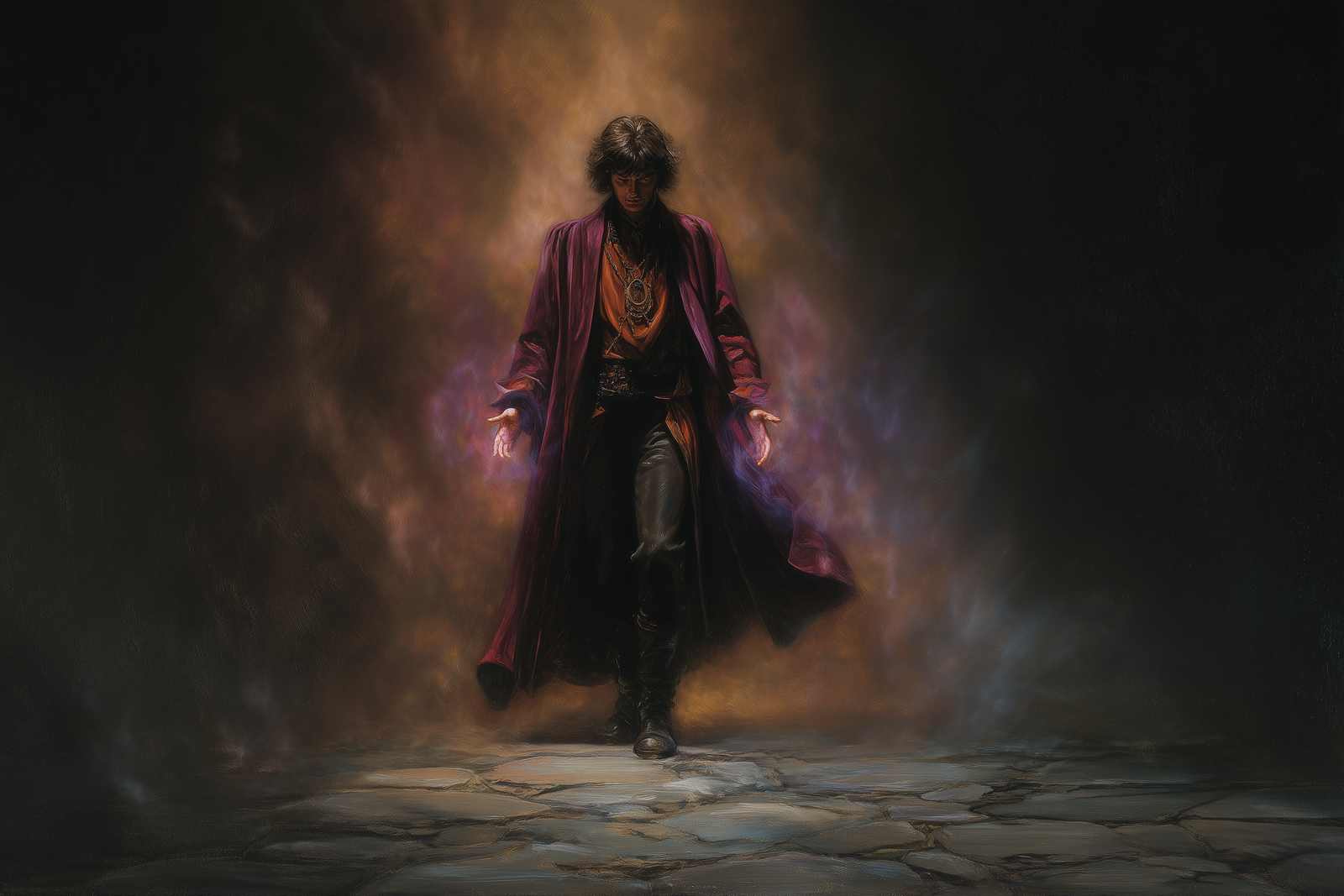
1. Nagavanshi Oracle
- Region & Origin: Ancient India (Nagavansha serpent lineage)
- Primary Arms: Sandalwood ritual staff
- Secondary Arms: Curved ritual blade (ceremonial)
- Armor Options: Padded silk robes, jewelry as magical wards
- Special Equipment: Bloodline amulet, gemstone focus, sacred cowrie shells
- Sorcerer Subclass: Draconic Sorcery (Gold Dragon)
- Deity Choices: Sarasvati, Kali, Agni
2. Berber Flame-Dancer
- Region & Origin: North Africa (Tuareg & Carthaginian influence)
- Primary Arms: Bronze double daggers
- Secondary Arms: Fire-wrought flint knife
- Armor Options: Flowing desert silks, fireproofed linen
- Special Equipment: Pouch of volcanic ash, flame dance talismans
- Sorcerer Subclass: Wild Magic Sorcery
- Deity Choices: Tanit, Baal Hammon
3. Norse Stormcaller
- Region & Origin: Viking Age Scandinavia
- Primary Arms: Iron-bound oaken staff
- Secondary Arms: Seax (short Norse dagger)
- Armor Options: Wolf pelt cloak, leather with iron inlays
- Special Equipment: Storm rune stone, bear-tooth totem
- Sorcerer Subclass: Wild Magic or Storm Sorcery (if allowed)
- Deity Choices: Thor, Freyja, Odin
4. Ainu Bone-Caller
- Region & Origin: Japan (Hokkaido – Ainu people)
- Primary Arms: Bone-carved spirit staff
- Secondary Arms: Antler-bladed knife
- Armor Options: Bearhide armor, fur layers
- Special Equipment: Whale-bone flute, charm belt, ivory talismans
- Sorcerer Subclass: Aberrant Sorcery
- Deity Choices: Kamuy, Chisei (spirit ancestors)
5. Mesoamerican Blood Sorcerer
- Region & Origin: Aztec Empire
- Primary Arms: Obsidian-bladed macuahuitl
- Secondary Arms: Ritual dagger
- Armor Options: Jaguar hide or feathered tunic
- Special Equipment: Incense pouches, codices, obsidian mirror
- Sorcerer Subclass: Wild Magic Sorcery
- Deity Choices: Quetzalcoatl, Tezcatlipoca, Huitzilopochtli
6. Wu Mystic of the Han Court
- Region & Origin: Ancient China (Han Dynasty)
- Primary Arms: Lacquered ritual fan
- Secondary Arms: Jade-hilted dagger
- Armor Options: Silk ritual robes, dragon-scale motif
- Special Equipment: Paper talismans, star chart scrolls
- Sorcerer Subclass: Clockwork Sorcery
- Deity Choices: Nüwa, Shangdi, Xi Wangmu
7. Tuareg Starborn
- Region & Origin: Sahara Desert (Tuareg nomads)
- Primary Arms: Meteorite curved blade
- Secondary Arms: Throwing knives
- Armor Options: Indigo-dyed layered robes, leather greaves
- Special Equipment: Star-map jewelry, obsidian mirror
- Sorcerer Subclass: Aberrant Sorcery
- Deity Choices: Amanai (Tuareg sky goddess), Aten
8. Khmer Dragon-Blooded Heir
- Region & Origin: Ancient Cambodia (Khmer Empire)
- Primary Arms: Coral-and-gold arcane spear
- Secondary Arms: Ceremonial short blade
- Armor Options: Dragon-scale embossed leather armor
- Special Equipment: Lotus incense, ancestral scrolls
- Sorcerer Subclass: Draconic Sorcery (Bronze Dragon)
- Deity Choices: Nāga, Shiva, Vishnu
9. Yoruba Dream-Talker
- Region & Origin: West Africa (Yoruba culture)
- Primary Arms: Iron ring staff
- Secondary Arms: Beaded whip for ritual dances
- Armor Options: White linens, sacred beads
- Special Equipment: Cowrie divination kit, ash markings
- Sorcerer Subclass: Divine Soul Sorcery
- Deity Choices: Orunmila, Oshun, Shango
10. Vietnamese Jungle Whisperer
- Region & Origin: Ancient Vietnam
- Primary Arms: Curved jungle machete
- Secondary Arms: Sling with herbal firestones
- Armor Options: Bark-and-hide armor
- Special Equipment: Monkey-skull fetish, spirit gourd
- Sorcerer Subclass: Wild Magic Sorcery
- Deity Choices: Son Tinh, local forest spirits
11. Greek Horologue
- Region & Origin: Hellenistic Greece (Alexandria)
- Primary Arms: Astrolabe wand
- Secondary Arms: Bronze dagger
- Armor Options: Robes woven with astronomical symbols
- Special Equipment: Hourglass focus, gear-inscribed scroll case
- Sorcerer Subclass: Clockwork Sorcery
- Deity Choices: Chronos, Athena, Hermes
12. Inuit Whisper of the Tundra
- Region & Origin: Arctic Circle (Inuit cultures)
- Primary Arms: Whale-bone harpoon
- Secondary Arms: Ice dagger carved from glacial magic
- Armor Options: Sealskin and fur cloak, snow boots
- Special Equipment: Ivory runes, aurora focus pendant
- Sorcerer Subclass: Aberrant Sorcery
- Deity Choices: Sedna, Nanook, the Moon Woman
Racial Sorcerer
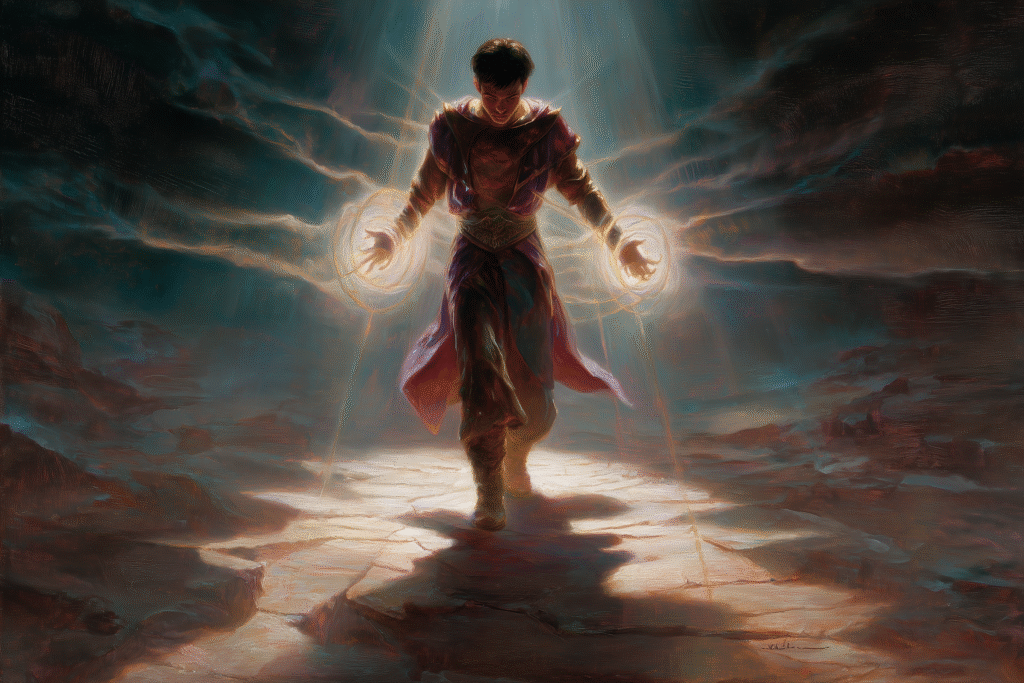
1. Elves
- Region & Origin: Europe (Celtic, Norse, Greek mythology)
- Primary Arms: Quarterstaff (engraved with nature symbols), Shortbow, Dagger
- Secondary Arms: Shuriken (small, quick throwing blades)
- Armor Options: Leather Armor (light and flexible)
- Special Equipment: Arcane Focus (Crystal or Wand), Spell Components Pouch, Nature’s Token (a small trinket from the natural world, enhancing their connection to magic)
- Sorcerer Subclasses: Shadow Sorcery, Divine Soul Sorcery
- Deity Choices: Corellon Larethian, Sehanine Moonbow, The Green Man
2. Dwarves
- Region & Origin: Northern Europe (Scandinavian, Germanic mythology)
- Primary Arms: Warhammer, Handaxe, Throwing Hammer
- Secondary Arms: Dagger (short, practical, and durable)
- Armor Options: Leather Armor, Hide Armor (tough and protective, but light)
- Special Equipment: Arcane Focus (Rune-inscribed Hammer), Spell Components Pouch, Dwarven Token (a small enchanted stone that reminds them of their heritage)
- Sorcerer Subclasses: Storm Sorcery, Divine Soul Sorcery
- Deity Choices: Moradin, Berronar Truesilver, Thor
3. Halflings
- Region & Origin: British Isles (Celtic, Anglo-Saxon folklore)
- Primary Arms: Slingshot, Small Dagger, Hand Crossbow
- Secondary Arms: Dart (light and thrown for precision)
- Armor Options: Leather Armor, Hide Armor (crafted for comfort and ease of movement)
- Special Equipment: Arcane Focus (Small Crystal or Charm), Spell Components Pouch, Lucky Coin (grants them a sense of good fortune, a signature of their lucky nature)
- Sorcerer Subclasses: Wild Magic Sorcery
- Deity Choices: Yondalla, Brigit, Cernunnos
4. Gnomes
- Region & Origin: Central and Eastern Europe (Germanic folklore, Alpine mythology)
- Primary Arms: Tinker’s Hammer, Slingshot, Light Crossbow
- Secondary Arms: Dagger
- Armor Options: Leather Armor, Studded Leather Armor (small, crafted for maneuverability)
- Special Equipment: Arcane Focus (Mechanical Gadget or Clockwork Piece), Spell Components Pouch, Tinker’s Tools (for crafting and minor enchantments)
- Sorcerer Subclasses: Clockwork Sorcery
- Deity Choices: Garl Glittergold, Moradin, Hephaestus
5. Orcs
- Region & Origin: Central Asia, Eurasian Steppe (Turkic, Mongol, Indo-European mythologies)
- Primary Arms: Spear, Bone Dagger, Throwing Axes
- Secondary Arms: Javelin (quick and simple)
- Armor Options: Leather Armor, Hide Armor (built for resilience and speed)
- Special Equipment: Arcane Focus (Totem or Tribal Artifact), Spell Components Pouch, Warrior’s Token (a trinket passed down from their ancestors to enhance their warrior spirit)
- Sorcerer Subclasses: Draconic Sorcery
- Deity Choices: Gruumsh, Shamash, Perun
6. Tieflings
- Region & Origin: Middle Eastern, Persian, Mediterranean (ancient demonology, Zoroastrianism)
- Primary Arms: Pitchfork, Dagger, Shortsword
- Secondary Arms: Scourge (whip-like weapon)
- Armor Options: Leather Armor, Studded Leather Armor (light but protective)
- Special Equipment: Arcane Focus (Infernal Symbol or Sigil), Spell Components Pouch, Infernal Token (a small charm that connects them to their infernal heritage)
- Sorcerer Subclasses: Divine Soul Sorcery, Shadow Sorcery
- Deity Choices: Asmodeus, Iblis, Ahriman
7. Dragonborn
- Region & Origin: Central Asia, East Asia (Mongolian, Chinese, and Indian influences)
- Primary Arms: Dagger, Light Crossbow, Spear
- Secondary Arms: Javelin (thrown for ranged attack)
- Armor Options: Leather Armor, Hide Armor (sturdy and durable)
- Special Equipment: Arcane Focus (Dragon-shaped Figurine or Gem), Spell Components Pouch, Draconic Token (an amulet signifying their dragon blood)
- Sorcerer Subclasses: Draconic Sorcery
- Deity Choices: Bahamut, Tiamat, Agni
8. Aarakocra
- Region & Origin: Central and South America (Aztec, Mayan, Incan influences, Native American mythology)
- Primary Arms: Feathered Spear, Bone Dagger, Shortbow
- Secondary Arms: Dart (light and thrown for precision)
- Armor Options: Leather Armor (light and suitable for flight)
- Special Equipment: Arcane Focus (Feathered Totem or Windstone), Spell Components Pouch, Wind Token (a small charm that connects them to the wind)
- Sorcerer Subclasses: Storm Sorcery
- Deity Choices: Quetzalcoatl, Inti, Huitzilopochtli
9. Tabaxi
- Region & Origin: South America (Amazonian tribes, Incan and Mayan influence)
- Primary Arms: Claw-like Dagger, Blowgun, Shortbow
- Secondary Arms: Sling
- Armor Options: Leather Armor, Hide Armor (light for swift movement)
- Special Equipment: Arcane Focus (Jade or Feather Pendant), Spell Components Pouch, Lucky Charm (symbol of their connection to the wild)
- Sorcerer Subclasses: Wild Magic Sorcery
- Deity Choices: Ix Chel, Tlaloc
10. Firbolg
- Region & Origin: Europe (Celtic, Irish mythology, nature spirits)
- Primary Arms: Staff of the Forest, Spear, Wooden Club
- Secondary Arms: Dagger (short, effective)
- Armor Options: Leather Armor, Hide Armor (designed for ease in natural settings)
- Special Equipment: Arcane Focus (Wooden Totem or Nature Token), Spell Components Pouch, Forest Emblem (an item that connects them to the wild)
- Sorcerer Subclasses: Divine Soul Sorcery
- Deity Choices: The Green Man, Cernunnos, Danu
11. Goblins
- Region & Origin: Northern and Eastern Europe (Slavic, Germanic folklore)
- Primary Arms: Jagged Dagger, Light Crossbow, Sling
- Secondary Arms: Throwing Knife (small and practical)
- Armor Options: Leather Armor, Hide Armor (light but functional)
- Special Equipment: Arcane Focus (Mischievous Charm or Idol), Spell Components Pouch, Goblin Trinket (a talisman with mysterious origins)
- Sorcerer Subclasses: Wild Magic Sorcery
- Deity Choices: Baphomet, Lolth, Hecate
12. Kenku
- Region & Origin: East Asia (Japanese, Chinese mythological birds and creatures)
- Primary Arms: Feathered Staff, Dagger, Shortbow
- Secondary Arms: Sling
- Armor Options: Leather Armor, Silk Armor (light, designed for agility and stealth)
- Special Equipment: Arcane Focus (Bird-shaped Charm or Feather), Spell Components Pouch, Mimicry Token (a small charm that helps them harness the art of mimicry)
- Sorcerer Subclasses: Shadow Sorcery
- Deity Choices: Fujin, Raijin
Sorcerer Class (Pathfinder)
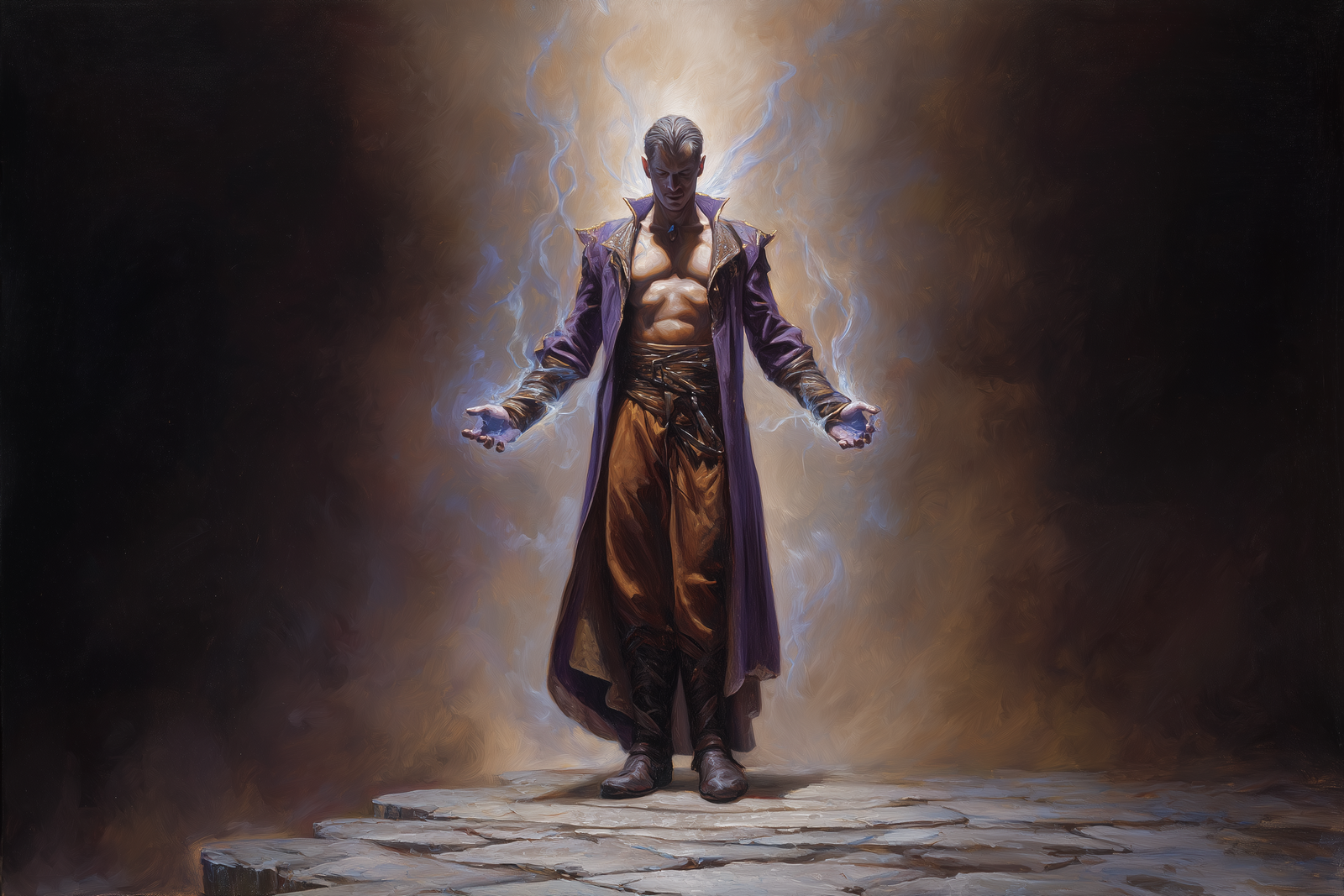
Scions of innately magical bloodlines, the chosen of deities, the spawn of monsters, pawns of fate and destiny, or simply flukes of fickle magic, sorcerers look within themselves for arcane prowess and draw forth might few mortals can imagine. Emboldened by lives ever threatening to be consumed by their innate powers, these magic-touched souls endlessly indulge in and refine their mysterious abilities, gradually learning how to harness their birthright and coax forth ever greater arcane feats.
Just as varied as these innately powerful spellcasters’ abilities and inspirations are the ways in which they choose to utilize their gifts. While some seek to control their abilities through meditation and discipline, becoming masters of their fantastic birthright, others give in to their magic, letting it rule their lives with often explosive results. Regardless, sorcerers live and breathe that which other spellcasters devote their lives to mastering, and for them magic is more than a boon or a field of study; it is life itself.
Role: Sorcerers excel at casting a selection of favored spells frequently, making them powerful battle mages. As they become familiar with a specific and ever-widening set of spells, sorcerers often discover new and versatile ways of making use of magics other spellcasters might overlook. Their bloodlines also grant them additional abilities, assuring that no two sorcerers are ever quite alike.
Alignment: Any
Hit Die: d6
Starting Wealth: 2d6 × 10 gp (average 70 gp.) In addition, each character begins play with an outfit worth 10 gp or less.
Class Skills
The sorcerer’s class skills (and the key ability for each skill) are Bluff (Charisma), Concentration (Constitution), Craft (Intelligence), Knowledge (arcana) (Intelligence), Profession(Wisdom), and Spellcraft (Intelligence).
Skill Points at 1st Level (2 + Intelligence modifier) x 4
Skill Points at Each Additional Level 2 + Intelligence modifier
| The Sorcerer | |||||||||||||||
| ———–Spells per Day——— | |||||||||||||||
| Level | Base Attack Bonus | Fort Save | Ref Save | Will Save | Special | 0 | 1st | 2nd | 3rd | 4th | 5th | 6th | 7th | 8th | 9th |
| 1st | +0 | +0 | +0 | +2 | Summon familiar | 5 | 3 | – | – | – | – | – | – | – | – |
| 2nd | +1 | +0 | +0 | +3 | 6 | 4 | – | – | – | – | – | – | – | – | |
| 3rd | +1 | +1 | +1 | +3 | 6 | 5 | – | – | – | – | – | – | – | – | |
| 4th | +2 | +1 | +1 | +4 | 6 | 6 | 3 | – | – | – | – | – | – | – | |
| 5th | +2 | +1 | +1 | +4 | 6 | 6 | 4 | – | – | – | – | – | – | – | |
| 6th | +3 | +2 | +2 | +5 | 6 | 6 | 5 | 3 | – | – | – | – | – | – | |
| 7th | +3 | +2 | +2 | +5 | 6 | 6 | 6 | 4 | – | – | – | – | – | – | |
| 8th | +4 | +2 | +2 | +6 | 6 | 6 | 6 | 5 | 3 | – | – | – | – | – | |
| 9th | +4 | +3 | +3 | +6 | 6 | 6 | 6 | 6 | 4 | – | – | – | – | – | |
| 10th | +5 | +3 | +3 | +7 | 6 | 6 | 6 | 6 | 5 | 3 | – | – | – | – | |
| 11th | +5 | +3 | +3 | +7 | 6 | 6 | 6 | 6 | 6 | 4 | – | – | – | – | |
| 12th | +6/+1 | +4 | +4 | +8 | 6 | 6 | 6 | 6 | 6 | 5 | 3 | – | – | – | |
| 13th | +6/+1 | +4 | +4 | +8 | 6 | 6 | 6 | 6 | 6 | 6 | 4 | – | – | – | |
| 14th | +7/+2 | +4 | +4 | +9 | 6 | 6 | 6 | 6 | 6 | 6 | 5 | 3 | – | – | |
| 15th | +7/+2 | +5 | +5 | +9 | 6 | 6 | 6 | 6 | 6 | 6 | 6 | 4 | – | – | |
| 16th | +8/+3 | +5 | +5 | +10 | 6 | 6 | 6 | 6 | 6 | 6 | 6 | 5 | 3 | – | |
| 17th | +8/+3 | +5 | +5 | +10 | 6 | 6 | 6 | 6 | 6 | 6 | 6 | 6 | 4 | – | |
| 18th | +9/+4 | +6 | +6 | +11 | 6 | 6 | 6 | 6 | 6 | 6 | 6 | 6 | 5 | 3 | |
| 19th | +9/+4 | +6 | +6 | +11 | 6 | 6 | 6 | 6 | 6 | 6 | 6 | 6 | 6 | 4 | |
| 20th | +10/+5 | +6 | +6 | +12 | 6 | 6 | 6 | 6 | 6 | 6 | 6 | 6 | 6 | 6 |
| Sorcerer Spells Known | ||||||||||
| ——– Spells Known ——— | ||||||||||
| Level | 0 | 1st | 2nd | 3rd | 4th | 5th | 6th | 7th | 8th | 9th |
| 1st | 4 | 2 | – | – | – | – | – | – | – | – |
| 2nd | 5 | 2 | – | – | – | – | – | – | – | – |
| 3rd | 5 | 3 | – | – | – | – | – | – | – | – |
| 4th | 6 | 3 | 1 | – | – | – | – | – | – | – |
| 5th | 6 | 4 | 2 | – | – | – | – | – | – | – |
| 6th | 7 | 4 | 2 | 1 | – | – | – | – | – | – |
| 7th | 7 | 5 | 3 | 2 | – | – | – | – | – | – |
| 8th | 8 | 5 | 3 | 2 | 1 | – | – | – | – | – |
| 9th | 8 | 5 | 4 | 3 | 2 | – | – | – | – | – |
| 10th | 9 | 5 | 4 | 3 | 2 | 1 | – | – | – | – |
| 11th | 9 | 5 | 5 | 4 | 3 | 2 | – | – | – | – |
| 12th | 9 | 5 | 5 | 4 | 3 | 2 | 1 | – | – | – |
| 13th | 9 | 5 | 5 | 4 | 4 | 3 | 2 | – | – | – |
| 14th | 9 | 5 | 5 | 4 | 4 | 3 | 2 | 1 | – | – |
| 15th | 9 | 5 | 5 | 4 | 4 | 4 | 3 | 2 | – | – |
| 16th | 9 | 5 | 5 | 4 | 4 | 4 | 3 | 2 | 1 | – |
| 17th | 9 | 5 | 5 | 4 | 4 | 4 | 3 | 3 | 2 | – |
| 18th | 9 | 5 | 5 | 4 | 4 | 4 | 3 | 3 | 2 | 1 |
| 19th | 9 | 5 | 5 | 4 | 4 | 4 | 3 | 3 | 3 | 2 |
| 20th | 9 | 5 | 5 | 4 | 4 | 4 | 3 | 3 | 3 | 3 |
Class Features
All of the following are class features of the sorcerer.
Weapon and Armor Proficiency
Sorcerers are proficient with all simple weapons. They are not proficient with any type of armor or shield. Armor of any type interferes with a sorcerer’s gestures, which can cause his spells with somatic components to fail.
Spells
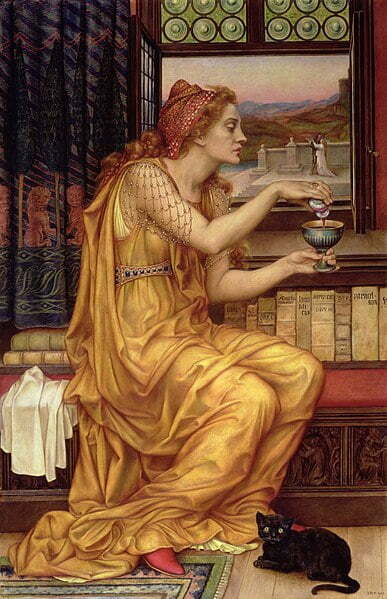
A sorcerer casts arcane spells which are drawn primarily from the sorcerer/wizard spell list. He can cast any spell he knows without preparing it ahead of time, the way a wizard or a cleric must (see below).
To learn or cast a spell, a sorcerer must have a Charisma score equal to at least 10 + the spell level. The Difficulty Class for a saving throw against a sorcerer’s spell is 10 + the spell level + the sorcerer’s Charisma modifier.
Like other spellcasters, a sorcerer can cast only a certain number of spells of each spell level per day. His base daily spell allotment is given on Table: The Sorcerer. In addition, he receives bonus spells per day if he has a high Charisma score.
A sorcerer’s selection of spells is extremely limited. A sorcerer begins play knowing four 0-level spells and two 1st-level spells of your choice. At each new sorcerer level, he gains one or more new spells, as indicated on Table: Sorcerer Spells Known. (Unlike spells per day, the number of spells a sorcerer knows is not affected by his Charisma score; the numbers on Table: Sorcerer Spells Known are fixed.) These new spells can be common spells chosen from the sorcerer/wizard spell list, or they can be unusual spells that the sorcerer has gained some understanding of by study. The sorcerer can’t use this method of spell acquisition to learn spells at a faster rate, however.
Upon reaching 4th level, and at every even-numbered sorcerer level after that (6th, 8th, and so on), a sorcerer can choose to learn a new spell in place of one he already knows. In effect, the sorcerer “loses” the old spell in exchange for the new one. The new spell’s level must be the same as that of the spell being exchanged, and it must be at least two levels lower than the highest-level sorcerer spell the sorcerer can cast. A sorcerer may swap only a single spell at any given level, and must choose whether or not to swap the spell at the same time that he gains new spells known for the level.
Unlike a wizard or a cleric, a sorcerer need not prepare his spells in advance. He can cast any spell he knows at any time, assuming he has not yet used up his spells per day for that spell level. He does not have to decide ahead of time which spells he’ll cast.
Familiar
A sorcerer can obtain a familiar (see familiars). Doing so takes 24 hours and uses up magical materials that cost 100 gp. A familiar is a magical beast that resembles a small animal and is unusually tough and intelligent. The creature serves as a companion and servant.
The sorcerer chooses the kind of familiar he gets. As the sorcerer advances in level, his familiar also increases in power.
If the familiar dies or is dismissed by the sorcerer, the sorcerer must attempt a DC 15 Fortitude saving throw. Failure means he loses 200 experience points per sorcerer level; success reduces the loss to one-half that amount. However, a sorcerer’s experience point total can never go below 0 as the result of a familiar’s demise or dismissal. A slain or dismissed familiar cannot be replaced for a year and day. A slain familiar can be raised from the dead just as a character can be, and it does not lose a level or a Constitution point when this happy event occurs.
A character with more than one class that grants a familiar may have only one familiar at a time.
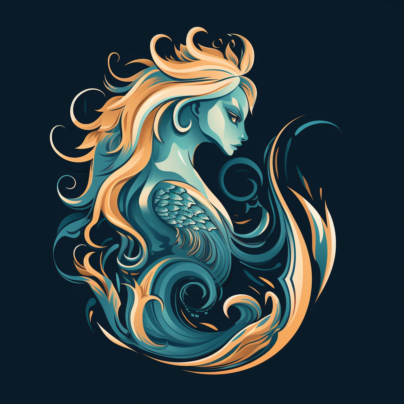
 Buy me a coffee
Buy me a coffee